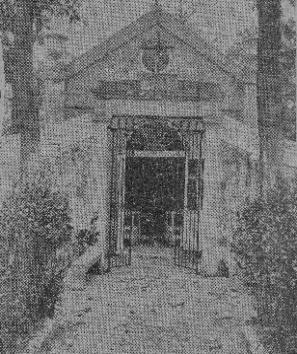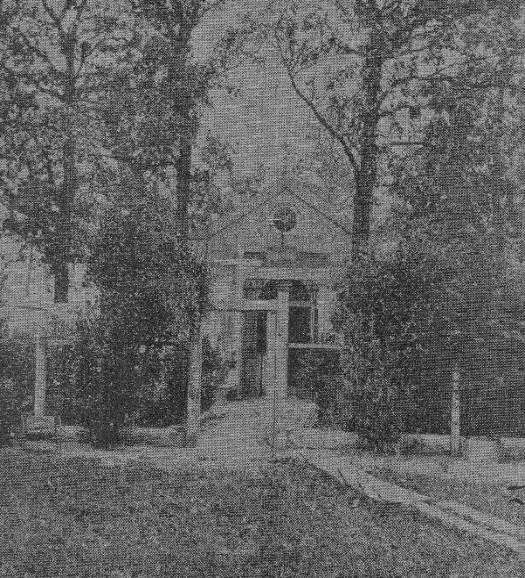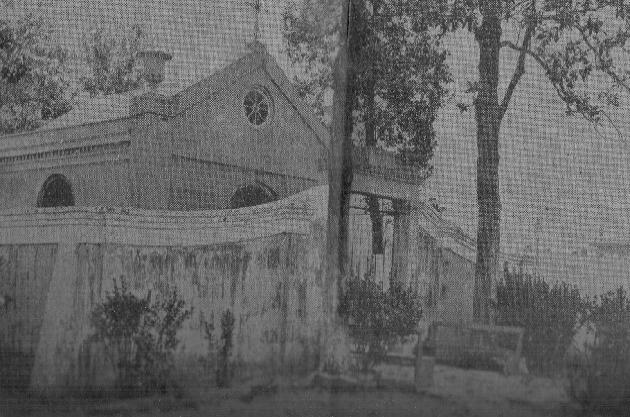

| The Old Duverje Chapel of Algiers |
| The old Duverje Chapel no longer exists. A playground, Delcazal Park, sits today where the Duverje plantation's graveyard and chapel were once located. The community of Algiers, across the river from New Orleans proper, but still within its city limits, rests, in part, on land purchased by Bartholemy Duverje in 1805. The house he built, completed in 1812, lasted until the great Algiers fire of 1895, at which time it was serving as the Algiers Courthouse. The family chapel and cemetery lasted until 1916. When the article below was written for The New Orleans Times-Democrat in 1910, none of the family members who contributed to the story knew that - in just a few years - the historic chapel would be torn down and the remains of their Duverje ancestors would be removed to Metairie Cemetery. I transcribed the article below from the original newspaper published in 1910. Because some of the print has worn away in the fold creases, I've had to guess at a few words, but most of it was quite legible, having survived the past hundred years in the safety of a scrapbook I found in a book shop in the French Quarter. The 3 photos are, also, from this article. -- Nancy Brister |
| Published in The New Orleans Times-Democrat - May, 1910 Quaint Chapel in Algiers Picturesque Private Graveyard with Memories of a Past Century The splendid old Duverje Plantation home no longer exists, but the picturesque chapel still stands to tell the story of the family and its changes - place still cared for with great care by descendants of the Duverjes. No doubt there are multitudes of people who have lived in this city all their lives and yet who do not know that in the very heart of Algiers is a private burial place a century old, and that the history of the suburb across the river is woven in with the little chapel which hides behind the high brick wall, surrounded by the last tributes to citizens important in their days. The history of the old place and its connection with Algiers goes back a long way. In 1770 Don Alexander O'Reilly, Spanish Governor of the Province of Louisiana, made a grant of extensive lands across the river to one Louis Borepo, who in his turn sold the land to Martial LeBoeuf. This last purchaser, in 1805, sold his newly acquired property to Bartholemy Duverje, who proceeded to build a home for himself and his family. It is probable that there was no home on the land up to this time. The city was on the other side of the river, and there was plenty of room in every direction. True, a hamlet of a few houses had sprung up in the neighborhood of the Duverje place and had been named Algiers by an old soldier who had returned from Spain's unsuccessful expedition against Algeria, and gave the name to the modern town which was to arise in a strange land. The old Duverje mansion, which burned down in the Algiers fire, is well remembered by everyone who ever crossed the river up to that time. It was the most conspicuous object in Algiers, and was so evidently a relic of old days that everyone who saw it paused for a closer inspection. When Bartholemy Duverje began the erection of those solid walls and those gigantic pillars, the pessimists stood around and told him he was throwing away time and money, for the river would inevitably, in course of the years, sweep the fine house away in some mighty flood; but he went on building. There is little doubt that he drew his own plans, and it is certain that he superintended the construction of the house, and saw that the work and the material were of the best. There was no such thing as time and weather crumbling the cement with which those walls were put together. Even the shingles on the roof, we are told, lasted for sixty years and the new shingles put on after that time were not as good as the ones which had just been taken off. Completed in 1812 In 1812, the house was completed and the Duverje family took possession of it; father and mother and children. All around them were plantations and orange groves. Neighbors were few and far between. Back of the beautiful home, with its view of the river's curve, were the slave quarters, for there was a colony of slaves to be taken care of. No doubt there were fine "functions" held in that old house and grand company assembled there and gallant courtiers and fair ladies promenaded up and down those long galleries. John McDonogh used to be a frequent visitor, going, perhaps, when he was sure that no other guest would be present; and gay company from across the river made its way over and there was much merry-making. Money was plentiful. The slaves were continually crossing the river with boatloads of vegetables and fruits; and coming back with bags of gold. Everything was as pleasant as things could be; the plantation belonged to old Bartholemy Duverje, and was always to remain in his family; and so, when some of the slaves died, he started a cemetery right there in the plantation. It was useless to have all the trouble of going across the river for a funeral--we would set aside this tract over here at the back for a burying ground and would keep it for that purpose forever. A portion of it could be walled in and a chapel built. It was a pretty spot, with trees all through it. It was to be the family cemetery always. And the mysterious part of it is that the cemetery still remains, a family cemetery, owned by private families, to this day; though the old Duverje plantation is the city of Algiers now, and thousands of homes cover what were once its orange groves and vegetable gardens. Seguin Street, a beautifully paved thoroughfare, runs past one of the high white walls. Not only that, it runs through what was once a part of the cemetery itself. The graves of the old slaves stood thick in that part; but the city wished ardently to run a street through, and argued and expropriated until the street was run and the walls were drawn in. As it is, however, an entire block belongs to the oldest private cemetery, perhaps in the United States, and above the high wall one can see the tops of the trees which make a delightful grove around the burial places of the dead. |
| The old chapel, 1910 |
| Chapel gate, 1910 |
| Kept up with care The heirs of Bartholemy Duverje still keep up the old cemetery with punctilious care. In one corner of the square is a cottage which is held, rent-free, by a family who give the place every attention; so that everything is kept in perfect order. Around the house are fig and other fruit trees and a little garden space; and there is a tiny park which is so shut off from the street and so shaded and cool that it is delightful in the summer heat. And then, over at one side, is the cemetery itself; a high brick wall, inclosing a space of about forty by sixty feet; and just inside the iron gate, a little chapel, as strong and well-built as though it were a fortress and were meant to stand a siege. And the chapel is the quaintest part of all; for while it is apparently a genuine chapel, very tiny, with a row of seats on either hand, and an altar facing the door, one has but to dismantle the altar and push it aside, and there are the doors of four tombs. They are covered with inscriptions, as one may see by drawing the draperies aside; and there is the tomb of Bartholemy Duverje, who came to the cemetery he had built ninety years ago; a pathetic inscription, telling how "Ce monument renfermo les restes de Bartholemy Duverje, age de 52 ans; d'Alix Bienvenu, son epouse, decedee le 8 Aout 1838, agee de 59 ans; de leurs enfans, Pierre, Helene et Bienvenu; et de Charles Godefroy Olivier, leur gendre, decede le 1 Juillet, 1835, age de 32 ans." There is, also, a tribute to the dead in the inscription to the effect that he was a man "sans reprche," which was not so rare a qualification in that day, perhaps, as it is now. [ The translation, or as close as I can get to it: "This monument holds the remains of Bartholemy Duverje, 52 years old; from Alix Bienvenu, his wife, deceased on August 8, 1838, 59 years old; their babies, Pierre, Helene and Bienvenu; and Charles Godefroy Olivier, their son-in-law, deceased on July 1, 1835, 32 years old." NB] Duverje family This old Duverje, dying, left five daughters and so the old Duverge faded out with the owner of the plantation; but the newer names which they took in marriage are inscribed on those oblongs of marble. There are the Villeres, the Oliviers, the Robelots, the LaVignes and the Coycaults buried here, and it is their descendants who bring their dead to this old resting place. Some of them come from far away. Not many months ago, one of the flock was brought back from Paris to be laid in the little cemetery on Seguin Street, on the old plantation of a hundred years ago. Three or four of them a year come through the iron gates and pass into the darkness and silence of some old tomb, opened to let them in. At least three or four hundred have been buried in those four tombs back of the altar and as many more in the other tombs outside, perhaps. If you pass out at one of the side doors of the little chapel, and go around to the back, you will find a collection of old tombs in the paved yard. Two of them in a corner among the trees are dedicated to members of the family; and two which stand in another corner, unmarked and partly sunken into the ground, but well built of brick, are tombs of old slaves; faithful friends of the family, who could not be neglected in death, any more than in life. In back of the high brick wall were the graves of the old slaves, the rank and file who had not so endeared themselves to the family. Fifty years ago the ground was thick with little crosses; but now crosses and all other signs have gone back into the dust, along with the bodies of those who were buried beneath them. There is but one alien, so to speak, in the entire cemetery. One of the pretty Duverje girls, who became Mrs. Coycault, had the misfortune to lose her beloved husband in early youth. In the course of time, she married Mr. Franklin Wharton, who in his turn, passed away in 1847 and left her a widow for the second time. When her own death was approaching and she was asked with which of these husbands she wished to be buried, she asked to be laid beside the husband of her youth. So the Wharton tomb stands alone just at the back of the chapel. Perhaps it is but natural for those descendants who are living now to look upon him as something of an outsider. He has relatives, not direct descendants, still living in this city; but they have no claim to burial in the old Duverje tomb; and so he remains alone, forsaken even by his wife. But, perhaps, he doesn't mind it now. No doubt death reconciles one to many things which were intolerable while one lived. Some of the streets of Algiers have caught the names which are carved on these old tombs. There is an Eliza Street and an Alix Street and an Evalina Street, all named for the fair young girls who used to make merry in the old Duverje mansion. There is an Olivier Street, too; and other of the family names which were incorporated into the city. |
| Another view of the chapel, 1910 |
| On All Saints Day Once a year on All Saints, there used to be a great celebration, for years after the death of Bartholmey Duverje. Archbishop Perche, well-beloved so long ago, was a devoted friend of the family and used to come and hold mass there every All Saints with none but the family present; and then a collation was spread on the lawn or in the beautiful grove adjoining; and the occasion was made a time of family reunion and a pleasant intercourse with friends. Of late years, the programme is changed to some slight extent. Once again, as of old, the family gathers there, and a carriage is sent for a priest, usually the local priest of St. Mary's, and the tombs are blessed, but there are none of the friendly groups in the groves as of old. "Suppose the family should die out?" asked a member of that group who has so cherished this little spot during many long years. "Well, it is hardly probable that it will, for there are a good many of us still. It might be possible, however, that a time would come when those who were left would not care to keep up the cemetery as it is kept now. Then, I think the proper thing to do would be to erect a monument to Barholemy Duverje, and turn the square into a park for the city. You can understand that we could not make merchandise of a place that has held the ashes of our dead." So, for a hundred years, this picturesque little spot has remained in the possession of one family. All around it is the noise of traffic; yet it stays on, the one still and solemn spot in the heart of the city; a monument to the family love and fixed purpose of men in whose veins runs the blood of the pioneers. |
| The link to this page is: http://old-new-orleans.com/NO_Duverje_Chapel.html Back to Old New Orleans Whispers - Home |
